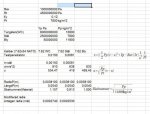obak
Hero
- Joined
- 17 Jul 2013
- Messages
- 1,252
Hej.
Sitter och räknar på hur många milimeter plåt en kula kan tränga igenom, eller ja, arbetar mig igenom ett manuskrip skrivet av nån som förstår sig på det, har dock kört fast.
Kan nån förklara för mig vad fan karln menar med:
The length of the bullet is calculated as if a constant radius given by half the caliber for the density of lead, actual radius of the core is then found by scaling the caliber by ?(?[SUB]p[/SUB] / 11800 kg/m²);
Länk för ref.
http://panoptesv.com/RPGs/Equipment/Weapons/Projectile_physics.php
Sitter och räknar på hur många milimeter plåt en kula kan tränga igenom, eller ja, arbetar mig igenom ett manuskrip skrivet av nån som förstår sig på det, har dock kört fast.
Kan nån förklara för mig vad fan karln menar med:
The length of the bullet is calculated as if a constant radius given by half the caliber for the density of lead, actual radius of the core is then found by scaling the caliber by ?(?[SUB]p[/SUB] / 11800 kg/m²);
Länk för ref.
http://panoptesv.com/RPGs/Equipment/Weapons/Projectile_physics.php

